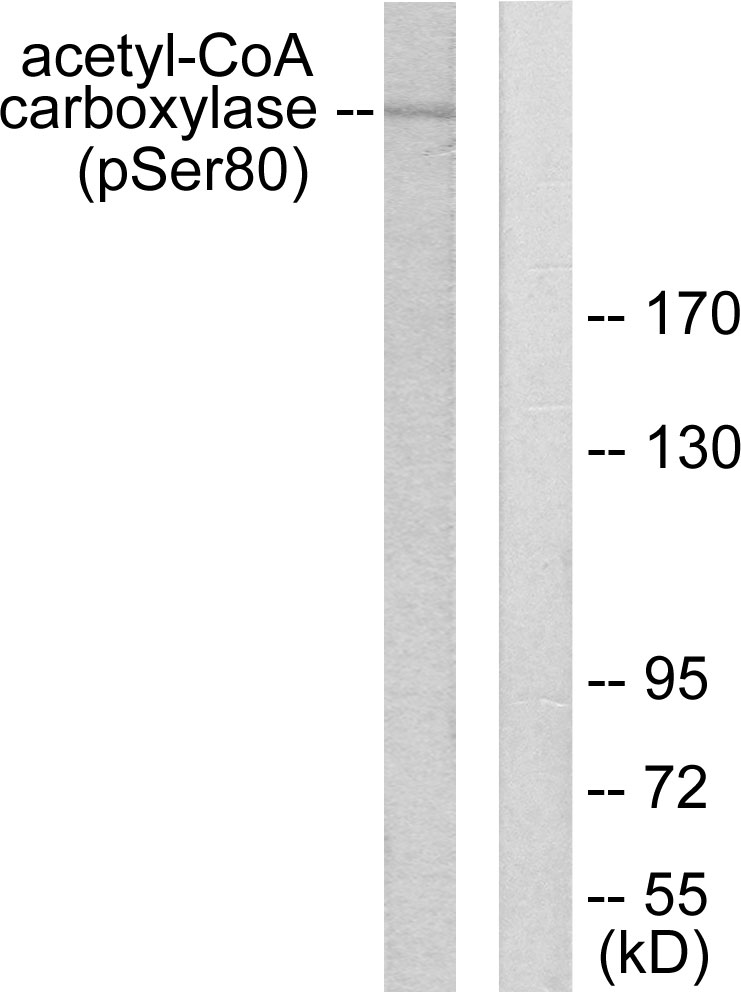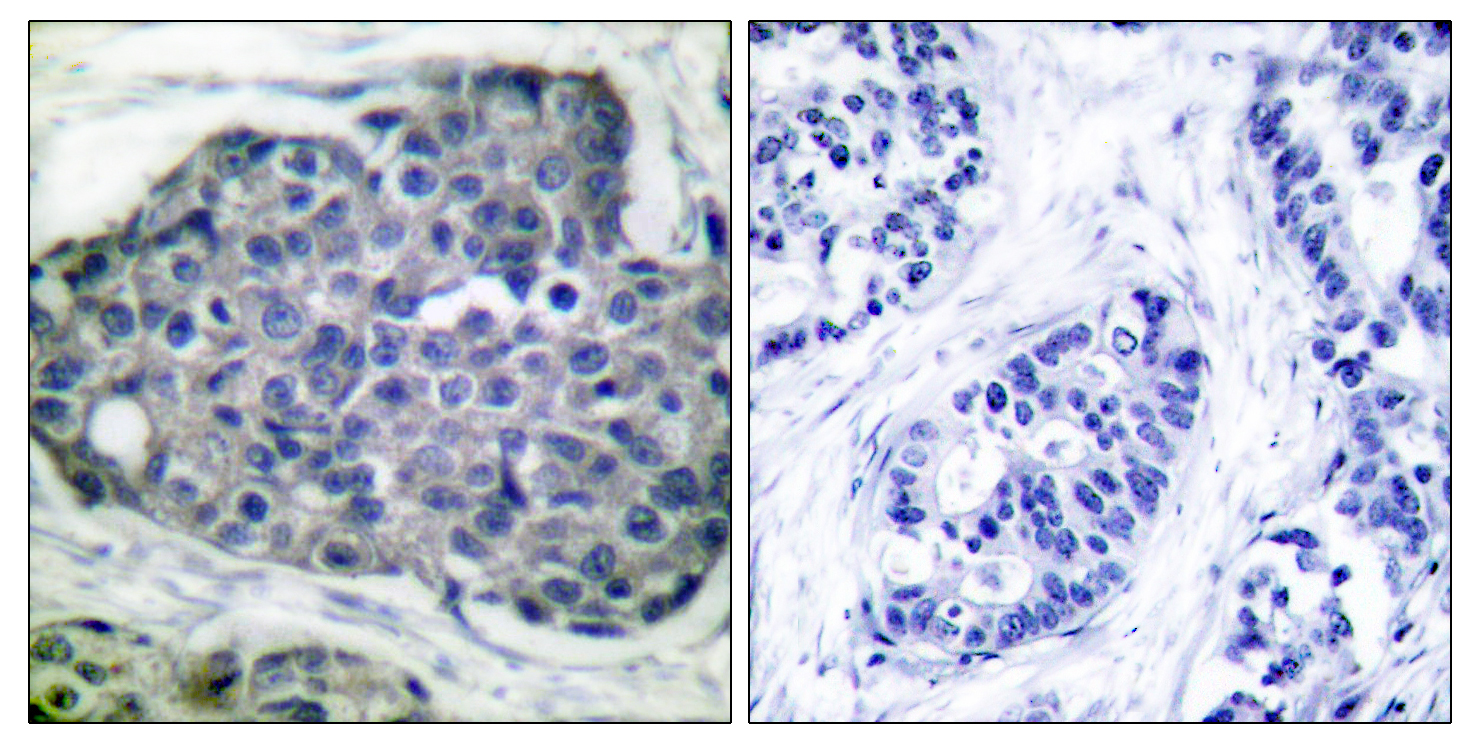Acetyl-CoA Carboxylase (Phospho-Ser80) Antibody
Purified Rabbit Polyclonal Antibody (Pab)
- SPECIFICATION
- CITATIONS
- PROTOCOLS
- BACKGROUND

Application
| WB, IHC |
|---|---|
| Primary Accession | Q13085 |
| Reactivity | Human, Mouse, Rat |
| Host | Rabbit |
| Clonality | Polyclonal |
| Calculated MW | 265554 Da |
| Gene ID | 31 |
|---|---|
| Other Names | Acetyl-CoA carboxylase 1, ACC1, ACC-alpha, Biotin carboxylase, ACACA, ACAC, ACC1, ACCA |
| Dilution | WB~~1:1000 IHC~~1:50~100 |
| Format | Rabbit IgG in phosphate buffered saline (without Mg2+ and Ca2+), pH 7.4, 150mM NaCl, 0.09% (W/V) sodium azide and 50% glycerol. |
| Storage Conditions | -20℃ |
| Name | ACACA (HGNC:84) |
|---|---|
| Synonyms | ACAC, ACC1, ACCA |
| Function | Cytosolic enzyme that catalyzes the carboxylation of acetyl- CoA to malonyl-CoA, the first and rate-limiting step of de novo fatty acid biosynthesis (PubMed:20457939, PubMed:20952656, PubMed:29899443). This is a 2 steps reaction starting with the ATP-dependent carboxylation of the biotin carried by the biotin carboxyl carrier (BCC) domain followed by the transfer of the carboxyl group from carboxylated biotin to acetyl-CoA (PubMed:20457939, PubMed:20952656, PubMed:29899443). |
| Cellular Location | Cytoplasm, cytosol {ECO:0000250|UniProtKB:Q5SWU9} |
| Tissue Location | Expressed in brain, placenta, skeletal muscle, renal, pancreatic and adipose tissues; expressed at low level in pulmonary tissue; not detected in the liver |

Thousands of laboratories across the world have published research that depended on the performance of antibodies from Abcepta to advance their research. Check out links to articles that cite our products in major peer-reviewed journals, organized by research category.
info@abcepta.com, and receive a free "I Love Antibodies" mug.
Provided below are standard protocols that you may find useful for product applications.
Background
Catalyzes the rate-limiting reaction in the biogenesis of long-chain fatty acids. Carries out three functions: biotin carboxyl carrier protein, biotin carboxylase and carboxyltransferase.
References
Abu-Elheiga L.,et al.Proc. Natl. Acad. Sci. U.S.A. 92:4011-4015(1995).
Mao J.,et al.Proc. Natl. Acad. Sci. U.S.A. 100:7515-7520(2003).
Sinilnikova O.M.,et al.Carcinogenesis 25:2417-2424(2004).
Travers M.T.,et al.Biochim. Biophys. Acta 1634:97-106(2003).
Travers M.T.,et al.Genomics 85:71-84(2005).
If you have used an Abcepta product and would like to share how it has performed, please click on the "Submit Review" button and provide the requested information. Our staff will examine and post your review and contact you if needed.
If you have any additional inquiries please email technical services at tech@abcepta.com.













 Foundational characteristics of cancer include proliferation, angiogenesis, migration, evasion of apoptosis, and cellular immortality. Find key markers for these cellular processes and antibodies to detect them.
Foundational characteristics of cancer include proliferation, angiogenesis, migration, evasion of apoptosis, and cellular immortality. Find key markers for these cellular processes and antibodies to detect them. The SUMOplot™ Analysis Program predicts and scores sumoylation sites in your protein. SUMOylation is a post-translational modification involved in various cellular processes, such as nuclear-cytosolic transport, transcriptional regulation, apoptosis, protein stability, response to stress, and progression through the cell cycle.
The SUMOplot™ Analysis Program predicts and scores sumoylation sites in your protein. SUMOylation is a post-translational modification involved in various cellular processes, such as nuclear-cytosolic transport, transcriptional regulation, apoptosis, protein stability, response to stress, and progression through the cell cycle. The Autophagy Receptor Motif Plotter predicts and scores autophagy receptor binding sites in your protein. Identifying proteins connected to this pathway is critical to understanding the role of autophagy in physiological as well as pathological processes such as development, differentiation, neurodegenerative diseases, stress, infection, and cancer.
The Autophagy Receptor Motif Plotter predicts and scores autophagy receptor binding sites in your protein. Identifying proteins connected to this pathway is critical to understanding the role of autophagy in physiological as well as pathological processes such as development, differentiation, neurodegenerative diseases, stress, infection, and cancer.



